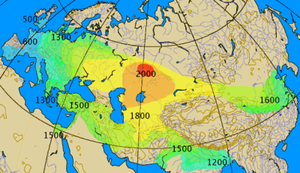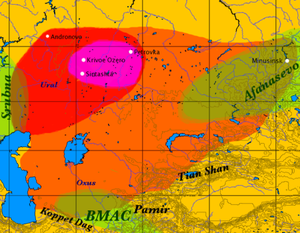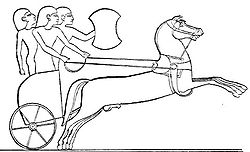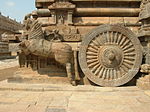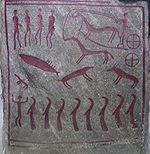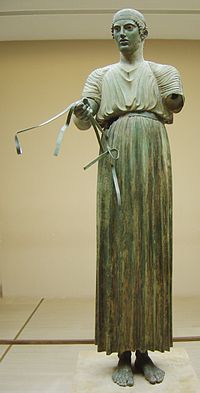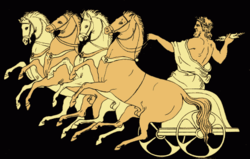- Chariot
-
For other uses, see Chariot (disambiguation).
The chariot is a type of horse carriage used in both peace and war as the chief vehicle of many ancient peoples. Ox carts, proto-chariots, were built by the Proto-Indo-Europeans and also built in Mesopotamia as early as 3000 BC. The original horse chariot was a fast, light, open, two wheeled conveyance drawn by two or more horses hitched side by side. The car was little more than a floor with a waist-high semicircular guard in front. The chariot, driven by a charioteer, was used for ancient warfare during the Bronze and Iron Ages, armor being provided by shields. The vehicle continued to be used for travel, processions and in games and races after it had been superseded for military purposes.The word "chariot" comes from Latin carrus, which itself was a loan from Gaulish. A chariot of war or of triumph was called a car. In ancient Rome and other ancient Mediterranean countries a biga was a two-horse chariot, a triga used three horses and a quadriga was drawn by four horses abreast. Obsolete terms for chariot include chair, charet and wain.
The critical invention that allowed the construction of light, horse-drawn chariots for use in battle was the spoked wheel. The earliest spoke-wheeled chariots date to ca. 2000 BC and their usage peaked around 1300 BC (see Battle of Kadesh). Chariots ceased to have military importance in the 4th century BC, but chariot races continued to be popular in Constantinople until the 6th century AD.
Contents
Early wheeled vehicles in Sumer


Relief of early war wagons on the Standard of Ur, c. 2500 BC The horse drawn wheeled vehicle probably originated in Mesopotamia about 3000 BC. The earliest depiction of vehicles in the context of warfare is on the Standard of Ur in southern Mesopotamia, c. 2500 BC. These are more properly called wagons or carts, still double-axled and pulled by oxen or tamed asses before the introduction of horses c. 2000 BC. Although sometimes carrying a spearman along with the charioteer (driver), such heavy proto-chariots, borne on solid wooden wheels and covered with skins, may have been part of the baggage train (e.g., during royal funeral processions) rather than vehicles of battle in themselves[citation needed]. The Sumerians had also a lighter, two-wheeled type of cart, pulled by four asses, but still with solid wheels. The spoked wheel did not appear in Mesopotamia until the mid-2000s BC.
Early Indo-Iranians
The earliest fully developed true chariots known are from the chariot burials of the Andronovo (Timber-Grave) sites of the Sintashta-Petrovka Proto-Indo-Iranian culture in modern Russia and Kazakhstan from around 2000 BC. This culture is at least partially derived from the earlier Yamna culture. It built heavily fortified settlements, engaged in bronze metallurgy on an industrial scale and practiced complex burial rituals reminiscent of Aryan rituals known from the Rigveda and the Avesta. The Sintashta-Petrovka chariot burials yield the earliest spoke-wheeled true chariots. The Andronovo culture over the next few centuries spread across the steppes from the Urals to the Tien Shan, likely corresponding to early Indo-Iranian cultures which eventually spread to Iran, Pakistan and parts of India in the course of the 2nd millennium BC.
Chariots figure prominently in Indo-Iranian mythology. Chariots are also an important part of both Hindu and Persian mythology, with most of the gods in their pantheon portrayed as riding them. The Sanskrit word for a chariot is ratha, a collective word Proto-Indo-European *rot-o- for "wheel" from *ret-h- 'to run' that also resulted in Latin rota and is also found in Germanic, Celtic and Baltic.
Ancient Near East
Some scholars argue that the chariot was most likely a product of the ancient Near East early in the 2nd millennium BC.[1]
Hittites
The oldest testimony of chariot warfare in the Ancient Near East is the Old Hittite Anitta text (18th century BC), mentioning 40 teams of horses (40 ?Í-IM-DÌ ANŠE.KUR.RA?I.A) at the siege of Salatiwara. Since only teams are mentioned rather than explicitly chariots, the presence of chariots in the 18th century BC is considered somewhat uncertain. The first certain attestation of chariots in the Hittite Empire dates to the late 17th century BC (Hattusili I). A Hittite horse training text survives, attributed to Kikkuli the Mitanni (15th century BC).
The Hittites were renowned charioteers. They developed a new chariot design that had lighter wheels, with four spokes rather than eight, and which held three warriors instead of two. It could hold 3 warriors as the wheel was placed in the middle of the chariot and not at the back as in the Egyptian chariots. Hittite prosperity largely depended on their control of trade routes and natural resources, specifically metals. As the Hittites gained dominion over Mesopotamia, tensions flared among the neighboring Assyrians, Hurrians and Egyptians. Under Suppiluliuma I, the Hittites conquered Kadesh and eventually the whole of Syria. The Battle of Kadesh in 1274 BC is likely to have been the largest chariot battle ever fought, involving some five thousand chariots.
Egypt
Main article: Chariotry in ancient Egypt Ramses II fighting riding in a chariot at the Battle of Kadesh with two archers, one with the reins tied around the waist, to free both hands. Relief from Abu Simbel.
Ramses II fighting riding in a chariot at the Battle of Kadesh with two archers, one with the reins tied around the waist, to free both hands. Relief from Abu Simbel.
The chariot, together with the horse itself, was introduced to Egypt by the Hyksos invaders in the 16th century BC and undoubtedly contributed to their military success. In the remains of Egyptian and Assyrian art there are numerous representations of chariots, from which it may be seen with what richness they were sometimes ornamented. The chariots of the Egyptians and Assyrians, with whom the bow was the principal arm of attack, were richly mounted with quivers full of arrows. The Egyptians invented the yoke saddle for their chariot horses in c. 1500 BC. The best preserved examples of Egyptian chariots are the four specimens from the tomb of Tutankhamun.
Persia
Main article: Scythed chariot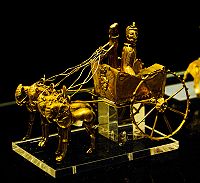 A golden chariot made during Achaemenid Empire in Persia. (550–330 BC)
A golden chariot made during Achaemenid Empire in Persia. (550–330 BC)
The Persians succeeded Elam in the mid 1st millennium. They may have been the first to yoke four horses (rather than two) to their chariots. They also used scythed chariots. Cyrus the Younger employed these chariots in large numbers. Herodotus mentions that the Libyans and the Indus satrapy supplied cavalry and chariots to Xerxes the Great's army. However, by this time cavalry was far more effective and agile than the chariot, and the defeat of Darius III at the Battle of Gaugamela (331 BC), where the army of Alexander simply opened their lines and let the chariots pass and attacked them from behind, marked the end of the era of chariot warfare.
Chariots in the Bible
- See also Merkabah.
Chariots are frequently mentioned in the Old Testament, particularly by the prophets, as instruments of war or as symbols of power or glory. First mentioned in the story of Joseph (Genesis 50:9), "Iron chariots" are mentioned also in Joshua (17:16,18) and Judges (1:19,4:3,13) as weapons of the Canaanites. 1 Samuel 13:5 mentions chariots of the Philistines, who are sometimes identified with the Sea Peoples or early Greeks. Such examples from the KJV here include:
- 2 Chronicles 1:14 And Solomon gathered chariots and horsemen: and he had a thousand and four hundred chariots, and twelve thousand horsemen, which he placed in the chariot cities, and with the king at Jerusalem.
- Judges 1:19 And the LORD was with Judah; and he drave out the inhabitants of the mountain; but could not drive out the inhabitants of the valley, because they had chariots of iron.
- Song of Solomon 1:9 I have compared thee, O my love, to a company of horses in Pharaoh's chariots.
- Ezekiel 26:10 By reason of the abundance of his horses their dust shall cover thee: thy walls shall shake at the noise of the horsemen, and of the wheels, and of the chariots, when he shall enter into thy gates, as men enter into a city wherein is made a breach.
- Isaiah 2:7 Their land also is full of silver and gold, neither is there any end of their treasures; their land is also full of horses, neither is there any end of their chariots.
- Jeremiah 4:13 Behold, he shall come up as clouds, and his chariots shall be as a whirlwind: his horses are swifter than eagles. Woe unto us! for we are ruined.
- Acts 8:37-38 Then Philip said, "If you believe with all your heart, you may." And he answered and said, "I believe that Jesus Christ is the Son of God." So he commanded the chariot to stand still. And both Philip and the eunuch went down into the water, and he baptized him.
Jezreel (city) has been identified as the chariot base of King Ahab.[2] And the decorated lynchpin of Sisera's chariot was identified at a site identified as his fortress Harosheth Haggoyim.[3]
India
Main article: RathaChariots figure prominently in the Rigveda, evidencing their presence in India in the 2nd millennium BC. They were most likely brought to the region by the Indo-European-speaking migrants from Central Asia, probably derived in part from their moving wagons. Among Rigvedic deities, notably Ushas (the dawn) rides in a chariot, as well as Agni in his function as a messenger between gods and men.
There are a few depictions of chariots among the petroglyphs in the sandstone of the Vindhya range. Two depictions of chariots are found in Morhana Pahar, Mirzapur district. One is shows a team of two horses, with the head of a single driver visible. The other one is drawn by four horses, has six-spoked wheels, and shows a driver standing up in a large chariot-box. This chariot is being attacked, with a figure wielding a shield and a mace standing at its path, and another figure armed with bow and arrow threatening its right flank. It has been suggested that the drawings record a story, most probably dating to the early centuries BC, from some centre in the area of the Ganges–Yamuna plain into the territory of still Neolithic hunting tribes.[4] The drawings would then be a representation of foreign technology, comparable to the Arnhem Land Aboriginal rock paintings depicting Westerners. The very realistic chariots carved into the Sanchi stupas are dated to roughly the 1st century.
The scythed chariot was invented by the King of Magadha, Ajatashatru around 475 BC. He used these chariots against the Licchavis.[citation needed] A scythed chariot was a war chariot with a sharp, sickle-shaped blade or blades mounted on each end of the axle. The blades, used as weapons, extended horizontally for a metre on the sides of the chariot.
China
Main article: Chariot (Ancient China)A bronze Chinese charioteer figurine made during the Warring States Period (403–221 BC).
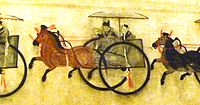 Powerful landlord in chariot. Eastern Han 25-220 CE. Anping, Hebei.
Powerful landlord in chariot. Eastern Han 25-220 CE. Anping, Hebei.
The earliest known chariot burial site in China, discovered in 1933 at Hougang, Anyang in central China's Henan Province, dates to the rule of King Wu Ding of the late Shang Dynasty (c. 1200 BC), but with literary evidence of chariot use in ancient China possibly from as early as the Xia Dynasty (21st-17th century BC).[5] During the Shang Dynasty, members of the royal family were buried with a complete household and servants, including a chariot, horses, and a charioteer. A Shang chariot was often drawn by two horses, but four-horse variants are occasionally found in burials. The crew consisted of an archer, a driver, and sometimes a third armed with a spear or dagger-axe known as the róngyòu (戎右). From the 8th to 5th centuries BC, Chinese use of chariots reached its peak. Although they appeared in greater numbers, infantry often defeated them in battle.
Jacques Gernet[6] claims that the Zhou dynasty, which conquered the Shang, made more use of the chariot than the Shang and "invented a new kind of harness with four horses abreast".
Massed chariot warfare became all but obsolete after the Warring States Period (476-221 BE). The main reasons were increased use of the crossbow, the adoption of standard cavalry units, and the adaptation of nomadic cavalry (mounted archery), which were more effective. Chariots would continue to serve as command posts for officers during the Qin and Han Dynasty whilst armored chariots were also used by the Han Dynasty against the Xiongnu Confederation in the Sino-Xiongnu War, specifically at the Battle of Mobei.
Europe
Eastern Europe
The domestication of the horse was an important step towards civilization, and the clearest evidence of early use of the horse as a means of transport is from chariot burials dated c. 2000 BCE. An increasing amount of evidence supports the hypothesis that horses were domesticated in the Eurasian Steppes (Dereivka centred in Ukraine) approximately 4000-3500 BCE.[7][8][9] Also the invention of the wheel most likely took place in Europe, evidence of wheeled vehicles appears from the mid 4th millennium BCE, near-simultaneously in the Northern Caucasus (Maykop culture) Central Europe and Mesopotamia. The earliest well-dated depiction of a wheeled vehicle (here a wagon—four wheels, two axles), is on the Bronocice pot, a ca. 3500–3350 BCE clay pot excavated in a Funnelbeaker culture settlement in southern Poland.[10] In the Armenian Kingdom of Van (Urartu), the chariot was used by the nobility and the military. In Erebuni (Yerevan), Armenia King Argishti of Urartu is depicted riding on a chariot which is dragged by two horses. The chariot has two wheels and each wheel has about eight spokes. This type of chariot was used around 800 BC.
Northern Europe
The Trundholm sun chariot is dated to c. 1400 BC (see Nordic Bronze Age). The horse drawing the solar disk runs on four wheels, and the Sun itself on two. All wheels have four spokes. The "chariot" consists solely of the solar disk, the axle, and the wheels, and it is unclear if the sun is imagined as being itself a chariot, or as riding in a chariot. The presence of a model of a horse-drawn vehicle on two spoked wheels in Northern Europe at such an early time is in any case astonishing.
In addition to the Trundholm chariot, there are a number of petroglyphs from the Nordic Bronze Age showing chariots, such as on one of the slabs of stone in a double burial from c. 1000 BC, showing a chariot with two four-spoked wheels drawn by a team of two horses.
The use of the composite bow from chariots is not attested in northern Europe.
Central Europe and Britain and Ireland
The Celts were famous chariot-makers, and the English word car is believed to be derived, via Latin carrum, from Gaulish karros (English chariot itself is from 13th century French charriote, an augmentative of the same word). Some 20 Iron Age chariot burials have been excavated in Britain, dating roughly from between 500 BC and 100 BC, virtually all of them in East Yorkshire, with the exception of one find of 2001 from Newbridge, 10 km west of Edinburgh.
The Celtic chariot (may have been called carpentom) was drawn by a team of two horses, and measured approximately 2 m (6.56 ft) in width and 4 m (13 ft) in length. The one-piece iron rims for chariot wheels were probably a Celtic invention. Apart from the iron wheel rims and iron fittings of the hub, it was constructed from wood and wicker-work. In some instances, iron rings reinforced the joints. Another Celtic innovation was the free-hanging axle, suspended from the platform with rope. This resulted in a much more comfortable ride on bumpy terrain. There is evidence from French coins of a leather 'suspension' system for the central box, and a complex system of knotted cords for its attachment; this has informed recent working reconstructions by archaeologists.
British chariots were open in front. Julius Caesar provides the only significant eyewitness report of British chariot warfare: "XXXIII.--Their mode of fighting with their chariots is this: firstly, they drive about in all directions and throw their weapons and generally break the ranks of the enemy with the very dread of their horses and the noise of their wheels; and when they have worked themselves in between the troops of horse, leap from their chariots and engage on foot. The charioteers in the meantime withdraw some little distance from the battle, and so place themselves with the chariots that, if their masters are overpowered by the number of the enemy, they may have a ready retreat to their own troops. Thus they display in battle the speed of horse, [together with] the firmness of infantry; and by daily practice and exercise attain to such expertness that they are accustomed, even on a declining and steep place, to check their horses at full speed, and manage and turn them in an instant and run along the pole, and stand on the yoke, and thence betake themselves with the greatest celerity to their chariots again."[11]
Chariots play an important role in Irish mythology surrounding the hero Cú Chulainn. The Celts in the Bronze Age used an ancient four-spoked wheel design called a sun cross or wheel cross to represent the chariot of the sun.[12]
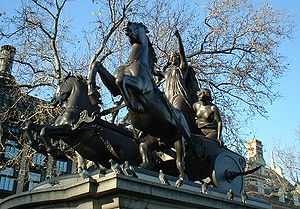 Sculpture by Thomas Thornycroft of Boudica and her daughters in her chariot, addressing her troops before the battle
Sculpture by Thomas Thornycroft of Boudica and her daughters in her chariot, addressing her troops before the battle
Chariots could also be used for ceremonial purposes. According to Tacitus (Annals 14.35), Boudica, queen of the Iceni and a number of other tribes in a formidable uprising against the occupying Roman forces, addressed her troops from a chariot in AD 61:
- "Boudicca curru filias prae se vehens, ut quamque nationem accesserat, solitum quidem Britannis feminarum ductu bellare testabatur"
- Boudicca, with her daughters before her in a chariot, went up to tribe after tribe, protesting that it was indeed usual for Britons to fight under the leadership of women.
The last mention of chariotry in battle seems to be at the Battle of Mons Graupius, somewhere in modern Scotland, in AD 84. From Tacitus (Agricola 1.35 -36) "The plain between resounded with the noise and with the rapid movements of chariots and cavalry." The chariots did not win even their initial engagement with the Roman auxiliaries: "Meantime the enemy's cavalry had fled, and the charioteers had mingled in the engagement of the infantry."
Southern Europe
The earliest records of chariots are the arsenal inventories of the Mycenaean palaces, as described in Linear B tablets from the 15th-14th centuries BC. The tablets distinguish between "assembled" and "disassembled" chariots.
Herodotus reports that chariots were widely used in the Pontic-Caspian steppe by the Sigynnae.
The only Etruscan chariot found intact dates to c. 530 BC, and was uncovered as part of a chariot burial at Monteleone di Spoleto. Currently in the collection of the Metropolitan Museum of Art,[13] it is decorated with bronze plates decorated with detailed low-relief scenes, commonly interpreted as depicting episodes from the life of Achilles.[14] Possibly unique to Etruscan chariots, the Monteleone chariot's wheels have nine spokes. As part of a chariot burial, the Monteleone chariot may have been intended primarily for ceremonial use and may not be representative of Etruscan chariots in general.
Greece
Chariot races were held in all Panhellenic Games. This bronze statue, the "Charioteer", was dedicated to the god Apollo in 474 BC by the tyrant of Gela in commemoration of a Pythian racing victory at Delphi.
The classical Greeks had a (still not very effective) cavalry arm, and the rocky terrain of the Greek mainland was unsuited for wheeled vehicles. Consequently, in historical Greece the chariot was never used to any extent in war. Nevertheless, the chariot retained a high status and memories of its era were handed down in epic poetry. Linear B tablets from Mycenaean palaces record large inventories of chariots, sometimes with specific details as to how many chariots were assembled or not (i.e. stored in modular form). Later the vehicles were used in games and processions, notably for races at the Olympic and Panathenaic Games and other public festivals in ancient Greece, in hippodromes and in contests called agons. They were also used in ceremonial functions, as when a paranymph, or friend of a bridegroom, went with him in a chariot to fetch the bride home.
Greek chariots were made to be drawn by two horses attached to a central pole. If two additional horses were added, they were attached on each side of the main pair by a single bar or trace fastened to the front or prow of the chariot, as may be seen on two prize vases in the British Museum from the Panathenaic Games at Athens, Greece, in which the driver is seated with feet resting on a board hanging down in front close to the legs of the horses. The biga itself consists of a seat resting on the axle, with a rail at each side to protect the driver from the wheels. Greek chariots appear to have lacked any other attachment for the horses, which would have made turning difficult.
The body or basket of the chariot rested directly on the axle (called beam) connecting the two wheels. There was no suspension, making this an uncomfortable form of transport. At the front and sides of the basket was a semicircular guard about 3 ft (1 m) high, to give some protection from enemy attack. At the back the basket was open, making it easy to mount and dismount. There was no seat, and generally only enough room for the driver and one passenger.
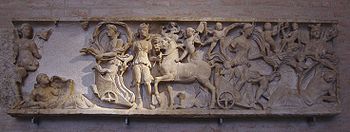

The chariot of Gaia depicted on a sarcophagus The central pole was probably attached to the middle of the axle, though it appears to spring from the front of the basket. At the end of the pole was the yoke, which consisted of two small saddles fitting the necks of the horses, and fastened by broad bands round the chest. Besides this the harness of each horse consisted of a bridle and a pair of reins.
The reins were mostly the same as those in use in the 19th century, and were made of leather and ornamented with studs of ivory or metal. The reins were passed through rings attached to the collar bands or yoke, and were long enough to be tied round the waist of the charioteer to allow for defence.
The wheels and basket of the chariot were usually of wood, strengthened in places with bronze or iron. They had from four to eight spokes and tires of bronze or iron.
Most other nations of this time had chariots of similar design to the Greeks, the chief differences being the mountings.
According to Greek mythology the chariot was invented by Erichthonius of Athens to conceal his feet, which were those of a dragon.[15]
The most notable appearance of the chariot in Greek mythology occurs when Phaëton, the son of Helios, in an attempt to drive the chariot of the sun, managed to set the earth on fire. This story led to the archaic meaning of a phaeton as one who drives a chariot or coach, especially at a reckless or dangerous speed. Plato, in his Chariot Allegory, depicted a chariot drawn by two horses, one well behaved and the other troublesome, representing opposite impulses of human nature; the task of the charioteer, representing reason, was to stop the horses from going different ways and to guide them towards enlightenment.
The Greek word for chariot, ἅρμα, hárma, is also used nowadays to denote a tank, properly called άρμα μάχης, árma mákhēs, literally a "combat chariot".
Rome
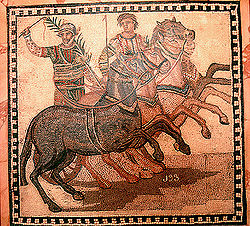

A winner of a Roman chariot race. The Romans probably borrowed chariot racing from the Etruscans, who would themselves have borrowed it either from the Celts or from the Greeks, but the Romans were also influenced directly by the Greeks especially after they conquered mainland Greece in 146 BC. In the Roman Empire, chariots were not used for warfare, but for chariot racing, especially in circi, or for triumphal processions, when they could be drawn by as many as ten horses or even by dogs, tigers, or ostriches. There were four divisions, or factiones, of charioteers, distinguished by the colour of their costumes: the red, blue, green and white teams. The main centre of chariot racing was the Circus Maximus,[16] situated in the valley between the Palatine and Aventine Hills in Rome. The track could hold 12 chariots, and the two sides of the track were separated by a raised median termed the spina. Chariot races continued to enjoy great popularity in Byzantine times, in the Hippodrome of Constantinople, even after the Olympic Games had been disbanded, until their decline after the Nika riots in the 6th century.The starting gates were known as the Carceres.
An ancient Roman car or chariot drawn by four horses abreast together with the horses drawing it was called a Quadriga, from the Latin quadrijugi (of a team of four). The term sometimes meant instead the four horses without the chariot or the chariot alone. A three-horse chariot, or the three-horse team drawing it, was a triga, from trijugi (of a team of three).
See also
- Chariot burial
- Chariot racing
- Chariot tactics
- Merkaba
- Ratha Sanskrit name for chariot
- Tachanka
- Tanks
- Temple car
- War Wagon
Notes
- ^ Raulwing 2000
- ^ David Ussishkin, "Jezreel—Where Jezebel Was Thrown to the Dogs", Biblical Archaeology Review July / August 2010.
- ^ [1]"Archaeological mystery solved," University of Haifa press release, July 1, 2010.
- ^ Sparreboom 1985:87
- ^ "Dynasties Witness Rise and Fall of Chariots". China.org. http://www.china.org.cn/english/MATERIAL/28792.htm. Retrieved October 7, 2010.
- ^ Gernet, Jacques. A History of Chinese Civilization, Cambridge University Press, 2nd edition 1996, ISBN 0-521-49781-7, p. 51.
- ^ Matossian Shaping World History p. 43
- ^ "What We Theorize – When and Where Did Domestication Occur". International Museum of the Horse. http://imh.org/legacy-of-the-horse/what-we-theorize-when-and-where-did-domestication-occur/. Retrieved 2010-12-12.
- ^ "Horsey-aeology, Binary Black Holes, Tracking Red Tides, Fish Re-evolution, Walk Like a Man, Fact or Fiction". Quirks and Quarks Podcast with Bob Macdonald (CBC Radio). 2009-03-07. http://www.cbc.ca/quirks/episode/2009/03/07/horsey-aeology-binary-black-holes-tracking-red-tides-fish-re-evolution-walk-like-a-man-fact-or-ficti/. Retrieved 2010-09-18.
- ^ Anthony, David A. (2007). The horse, the wheel, and language: how Bronze-Age riders from the Eurasian steppes shaped the modern world. Princeton, N.J: Princeton University Press. p. 67. ISBN 0-691-05887-3.
- ^ The Project Gutenberg EBook of "De Bello Gallico" and Other Commentaries by Caius Julius Caesar, translated by W. A. MacDevitt (1915).
- ^ Symbols.com - Symbol 29:1.
- ^ METmuseum.org
- ^ The Golden Chariot of Achilles
- ^ Brewer, E. Cobham. Dictionary of Phrase & Fable. Char’iot. Bartleby.com: Great Books Online – Encyclopedia, Dictionary, Thesaurus and hundreds more. Retrieved March 5, 2008.
- ^ The Charioteer of Delphi: Circus Maximus. The Roman Mysteries books by Caroline Lawrence.
References
- Anthony, D. W., & Vinogradov, N. B., Birth of the Chariot, Archaeology vol.48, no.2, Mar & April 1995, 36-41
- Anthony, David W., 1995, Horse, wagon & chariot: Indo-European languages and archaeology, Antiquity Sept/1995
- Di Cosmo, Nicolo, The Northern Frontier in Pre-Imperial China, Cambridge History of Ancient China ch. 13 (pp. 885–966).
- Litauer, M.A., & Grouwel, J.H., The Origin of the True Chariot', "Antiquity" vol.70, No.270, December 1996, 934-939.
- Sparreboom, M., Chariots in the Veda, Leiden (1985).
Further reading
- Anthony, David W. The Horse, The Wheel and Language: How Bronze-Age Riders from the Eurasian Steppes Shaped the Modern World Princeton: Princeton University Press, 2007 (ISBN 9780691058870).
- Chamberlin, J. Edward. Horse: How the horse has shaped civilizations. N.Y.: United Tribes Media Inc., 2006 (ISBN 0-9742405-9-1).
- Cotterell, Arthur. Chariot: From chariot to tank, the astounding rise and fall of the world's first war machine. Woodstock & New York: The Overlook Press, 2005 (ISBN 1-58567-667-5).
- Crouwel, Joost H. Chariots and other means of land transport in Bronze Age Greece (Allard Pierson Series, 3). Amsterdam: Allard Pierson Museum, 1981 (ISBN 90-71211-03-7).
- Crouwel, Joost H. Chariots and other wheeled vehicles in Iron Age Greece (Allard Pierson Series, 9). Amsterdam: Allard Pierson Museum:, 1993 (ISBN 90-71211-21-5).
- Drews, Robert. The coming of the Greeks: Indo-European conquests in the Aegean and the Near East. Princeton: Princeton University Press, 1988 (hardcover, ISBN 0-691-03592-X); 1989 (paperback, ISBN 0-691-02951-2).
- Drews, Robert. The end of the Bronze Age: Changes in warfare and the catastrophe ca. 1200 B.C. Princeton: Princeton University Press, 1993 (hardcover, ISBN 0-691-04811-8); 1995 (paperback, ISBN 0-691-02591-6).
- Drews, Robert. Early riders: The beginnings of mounted warfare in Asia and Europe. N.Y.: Routledge, 2004 (ISBN 0-415-32624-9).
- Lee-Stecum, Parshia (October 2006). "Dangerous Reputations: Charioteers and Magic in Fourth-Century Rome". Greece & Rome 53 (2): 224–234. doi:10.1017/S0017383506000295. ISSN 0017-3835.
- Fields, Nic; Brian Delf (illustrator). Bronze Age War Chariots (New Vanguard). Oxford; New York: Osprey Publishing, 2006 (ISBN 978-1841769448).
- Greenhalg, P A L. Early Greek warfare; horsemen and chariots in the Homeric and Archaic Ages. Cambridge University Press, 1973. (ISBN 9780521200561).
- Kulkarni, Raghunatha Purushottama. Visvakarmiya Rathalaksanam: Study of Ancient Indian Chariots: with a historical note, references, Sanskrit text, and translation in English. Delhi: Kanishka Publishing House, 1994 (ISBN 978-8173-91004-3)
- Littauer, Mary A.; Crouwel, Joost H. Chariots and related equipment from the tomb of Tutankhamun (Tutankhamun's Tomb Series, 8). Oxford: The Griffith Institute, 1985 (ISBN 0-900416-39-4).
- Littauer, Mary A.; Crouwel, Joost H.; Raulwing, Peter (Editor). Selected writings on chariots and other early vehicles, riding and harness (Culture and history of the ancient Near East, 6). Leiden: Brill Academic Publishers, 2002 (ISBN 90-04-11799-7).
- Moorey, P.R.S. "The Emergence of the Light, Horse-Drawn Chariot in the Near-East c. 2000–1500 B.C.", World Archaeology, Vol. 18, No. 2. (1986), pp. 196–215.
- Piggot, Stuart. The earliest wheeled transport from the Atlantic Coast to the Caspian Sea. Ithaca, NY: Cornell University Press, 1983 (ISBN 0-8014-1604-3).
- Piggot, Stuart. Wagon, chariot and carriage: Symbol and status in the history of transport. London: Thames & Hudson, 1992 (ISBN 0-500-25114-2).
- Pogrebova M. The emergence of chariots and riding in the South Caucasus in Oxford Journal of Archaeology, Volume 22, Number 4, November 2003, pp. 397–409.
- Raulwing, Peter. Horses, Chariots and Indo-Europeans: Foundations and Methods of Chariotry Research from the Viewpoint of Comparative Indo-European Linguistics. Budapest: Archaeolingua, 2000 (ISBN 9638046260).
- Sandor, Bela I. The rise and decline of the Tutankhamun-class chariot in Oxford Journal of Archaeology, Volume 23, Number 2, May 2004, pp. 153–175.
- Sandor, Bela I. Tutankhamun's chariots: Secret treasures of engineering mechanics in Fatigue & Fracture of Engineering Materials & Structures, Volume 27, Number 7, July 2004, pp. 637–646.
- Sparreboom M. Chariots in the Veda (Memoirs of the Kern Institute, Leiden, 3). Leiden: Brill Academic Publishers, 1985 (ISBN 90-04-07590-9).
External links
- Ancient Egyptian chariots: history, design, use. Ancient Egypt: an introduction to its history and culture.
- Chariot Usage in Greek Dark Age Warfare, by Carolyn Nicole Conter: Title page for Electronic Theses and Dissertations ETD etd-11152003-164515. Florida State University ETD Collection.
- Chariots in Greece. Hellenica - Michael Lahanas.
- Kamat Research Database - Prehistoric Carts. Varieties of Carts and Chariots in prehistoric cave shelter paintings found in Central India. Kamat's Potpourri – The History, Mystery, and Diversity of India.
- Ludi circenses (longer version). SocietasViaRomana.net.
- Remaking the Wheel: Evolution of the Chariot - New York Times. February 22, 1994.
Categories:- Warfare of the Ancient era
- Chariots
- Animal-powered vehicles
- Archaeological artefact types
- Indo-European
- Bronze Age
- Iron Age
Wikimedia Foundation. 2010.


